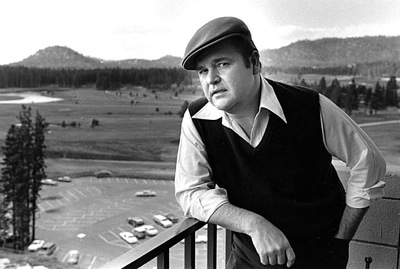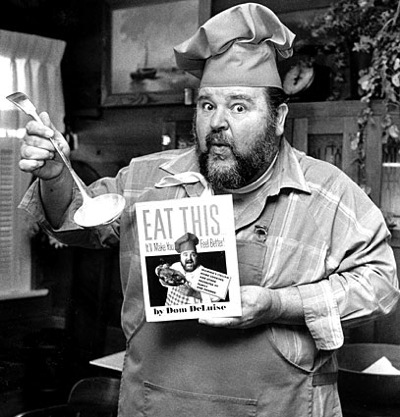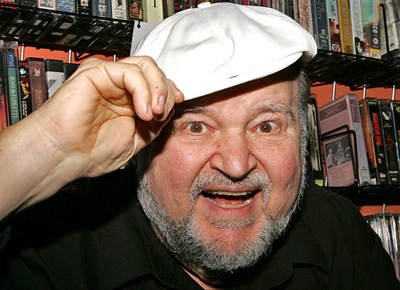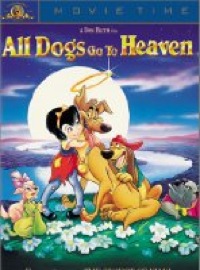Click here to print
Storing the Story of Dom DeLuise
posted December 30, 2010
When comic actor, director, television producer, and author Dom DeLuise died in 2009 at the age of 75, he left a large collection of materials relating to his career.
Much of the material has already gone to large collections. DeLuise’s heirs gave his feature-film material to the Margaret Herrick Library at the Academy of Motion Picture Arts and Sciences in Los Angeles and a huge collection of VHS tapes of his film and TV appearances to the American Comedy Archive at Emerson College in Boston.
Here, Nat Segaloff, the Los Angeles-based archivist for the Estate of Dom DeLuise, reports on the disposition of the great comedian’s collections, including the forthcoming donation of TV material to the UCLA Film & Television Archive.



 Over his 75 years, Dom saved practically everything he ever did, something which was not easy to do when he started his performing career in the early 1960s. My running joke was that he saved everything but not in one place. He and his wife, Carol Arthur, and their newborn son, Peter (later joined by sons Michael and David), lived in the same house in Pacific Palisades that they bought when they moved to California from New York in 1966. This was a boon for the cohesiveness of the material but not for its storage conditions. Items were kept not only in the house but in the attic, the pool house, the garage, a tool shed, and in closets.
Over his 75 years, Dom saved practically everything he ever did, something which was not easy to do when he started his performing career in the early 1960s. My running joke was that he saved everything but not in one place. He and his wife, Carol Arthur, and their newborn son, Peter (later joined by sons Michael and David), lived in the same house in Pacific Palisades that they bought when they moved to California from New York in 1966. This was a boon for the cohesiveness of the material but not for its storage conditions. Items were kept not only in the house but in the attic, the pool house, the garage, a tool shed, and in closets.
Dom had the foresight to acquire a number of 16mm B&W kinescopes of the 1968 The Dom DeLuise Show that he did as a summer replacement for Jackie Gleason in Florida; several episodes of The Entertainers that also included Carol Burnett, Ruth Buzzi, Bob Newhart, Caterina Valenti, John Davidson and other newcomers; a few guest appearances on episodics like The Ghost and Mrs. Muir; early TV commercials and sponsored films; and so forth. He also had a number of quad videotapes as well as the 1″ masters and work tapes for Dom DeLuise and Friends specials 1-2-3-4.
Dom recorded most of his Atlantic City and Las Vegas nightclub appearances on audiocassette, and was such a beloved interview guest that air personalities routinely sent him courtesy copies, usually on audiocassette, and later on video (both 3/4 and VHS). These, combined with airchecks and courtesy dubs of talk shows, satellite press tours, and raw field tapes provide a unique glimpse into not only his broadcast record but, in many cases, an education in how he shaped his performances. In several instances we can see him directing his own guest appearances from in front of the camera, advising the camera crew and floor director on the best way to capture his movements and how to time the camera moves.
The 3/4” and VHS tapes were declined by LA-based archives for different reasons. The image quality on VHS is substandard, of course, and the archives felt that, except for rare exceptions, they could track down the originals if need be. Fortunately, the American Comedy Archive at Emerson College in Boston was able to take the VHS and some of the 3/4.
The 3/4” U-matics were a problem. The technology is not only dated, it is hated. The LA-based archives I spoke with emphatically declined them on the grounds that they were so unstable that their flaking iron oxide would abrade their machines’ playback heads. Nevertheless, we were able to copy most of the 3/4s as well as the VHS cassettes onto DVD for the DeLuise family (understanding that DVD technology is even less stable than 3/4). The 1” and 2” were not copied, but, fortunately, VHS copies were made when the shows were new.
Then there was the 35mm elements and negatives in storage at Pacific Title Archives that I will get to in early 2011 that includes materials for Happy, the 1985 TV movie that Dom produced in which he plays a clown who witnesses a murder, and several 1” elements from a second Dom DeLuise Show that he and producer Greg Garrison did in 1985.
 As for paper, Dom not only kept letters, clippings, contracts, and publicity materials, but his sister Antoinette DeLuise Daurio in New York had compiled critically important scrapbooks of her younger brother’s early stage appearances. Through these it was possible to label most of the photos that Dom kept in boxes – without captions.
As for paper, Dom not only kept letters, clippings, contracts, and publicity materials, but his sister Antoinette DeLuise Daurio in New York had compiled critically important scrapbooks of her younger brother’s early stage appearances. Through these it was possible to label most of the photos that Dom kept in boxes – without captions.
The toughest part of archiving the Dom DeLuise papers was identifying things. Movie publicity photos weren’t much of a problem (although key sets, custom layouts, and behind-the-scenes home movies and snapshots posed a challenge), but the live theatre photos – especially where makeup disguised many actors – was a toughie. Because Dom and Carol (his wife) kept in touch with so many people from their lives and careers it was possible to consult those they knew from their early acting days.
I suspect that Dom drew comfort from having everything around him even if he knew he couldn’t lay his hands on it without moving a ton of boxes. Shortly after he died on May 4, 2009 the DeLuise family and their assistant, Elizabeth Adams, asked me to put his papers in order. He and I had become close friends over the last five years of his life (when his mobility had become restricted) so I was already more than casually familiar with his career, but the real advantage was that I am over 30 so I have an institutional memory of show business during his lifetime. It took several weeks to set up systems, after which the rest was identifying and dating materials and putting them in the correct folders. As things turned up, as fans sent mementos, and as family and friends offered their help, the collection expanded. We wound up with 55 bankers boxes of paper and another 30 of tapes.
 The Margaret Herrick Library at the Academy Foundation’s Center for Advanced Film Study eagerly accepted the paper, photos, and audio. The Academy Film Archive has the film and copies of many of the custom DVDs. Although we created a detailed inventory, the Herrick will produce a formal Finder as soon as they put the Dom DeLuise Special Collection into service.
The Margaret Herrick Library at the Academy Foundation’s Center for Advanced Film Study eagerly accepted the paper, photos, and audio. The Academy Film Archive has the film and copies of many of the custom DVDs. Although we created a detailed inventory, the Herrick will produce a formal Finder as soon as they put the Dom DeLuise Special Collection into service.
I also began working with Carol DeLuise who assembled her papers for donation to the UCLA Arts & Performance Special Collections. We went through letters, scrapbooks, posters, and photos and, as I typed the inventory, I added her personal annotations and reminiscences that enrich the collection. We also did several hours of oral history that I transcribed. In addition, Carol is an avid theatergoer and saved Playbills from the 1950s on. She donated this amazing collection (some of which are autographed; she is a fan as well as a well-credited Broadway performer herself) to Queens College in New York.
Dom’s tapes (TV-centric) will go to the UCLA Film and Television Archive once we have assembled them. UCLA is interested only in show masters, so there is some screening to do.
The DeLuise family – Carol in particular – were completely supportive of this archival effort to preserve Dom’s legacy. The materials are not only important for anyone wishing to know Dom’s life, but they offer a chance to become intimate with the craft of, arguably, the premiere comic actor of his generation.
 Nat Segaloff is a Los Angeles-based writer, producer, teacher, and journalist. His study of filmmaker Arthur Penn, Arthur Penn: American Director (University Press of Kentucky), will appear in April 2011. The book, written with Penn’s participation, is the first full-length book about Penn, and the first sustained treatment of the director since Robin Wood’s short monograph of more than 40 years ago. His writings have appeared in Film Comment, the Journal of the Producers Guild of America, and American Movie Classics Magazine. He is the author of Hurricane Billy: The Stormy Life and Films of William Friedkin (William Morrow, 1990) and coauthor of Love Stories: Hollywood’s Most Romantic Movies (Longmeadow Press, 1992). He is also the co-author of the play, The Meeting that Began the Blacklist.
Nat Segaloff is a Los Angeles-based writer, producer, teacher, and journalist. His study of filmmaker Arthur Penn, Arthur Penn: American Director (University Press of Kentucky), will appear in April 2011. The book, written with Penn’s participation, is the first full-length book about Penn, and the first sustained treatment of the director since Robin Wood’s short monograph of more than 40 years ago. His writings have appeared in Film Comment, the Journal of the Producers Guild of America, and American Movie Classics Magazine. He is the author of Hurricane Billy: The Stormy Life and Films of William Friedkin (William Morrow, 1990) and coauthor of Love Stories: Hollywood’s Most Romantic Movies (Longmeadow Press, 1992). He is also the co-author of the play, The Meeting that Began the Blacklist.
Printed from Moving Image Archive News: http://www.movingimagearchivenews.org
URL to article: http://www.movingimagearchivenews.org/storing-the-story-of-dom-deluise/
Click here to print